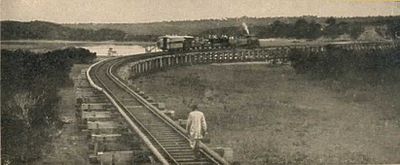User:Van Gulik/sandbox
This is development for the article Mombasa, section 'History'.
History
[edit]
In its early history, Mombasa was an important center for the trade of spices, gold and ivory, Most of the early information on Mombasa comes from Portuguese chroniclers writing in the 16th century. The famous Moroccan scholar and traveller Ibn Battuta did visit Mombasa in 1331 on his travels on the eastern coast of Africa and made some mention of the city, although he only stayed one night. He noted that the people of Mombasa were Shãfi'i Muslims, "a religious people, trustworthy and righteous. Their mosques are made of wood, expertly built."
The exact founding date of the city is unknown, but it has a long history. Kenyan school history books place the founding of Mombasa as 900 A.D. It must have been already a prosperous trading town in the 12th century, as the Arab geographer Al Idrisi mentions it in 1151.
During the pre-modern period, Mombasa was an important centre for the trade in spices, gold, and ivory. Its trade links reached as far as India and China and oral historians today can still recall this period of local history. India history shows that there was trade links between Mombasa and Cholas of South India. Throughout the early modern period, Mombasa was a key node in the complex and far reaching Indian Ocean trading networks, its key exports then were ivory, millet, sesamum and coconuts.
In the late pre-colonial period (late 19th century), it was the metropolis of a plantation society, which became dependent on slave labour (sources contradict whether the city was ever an important place for exporting slaves) but ivory caravans remained a major source of economic prosperity. Mombasa became the major port city of pre-colonial Kenya in the Middle Ages and was used to trade with other African port cities, Persia, Arab traders, Yemen India and China.[1] 15th century Portuguese voyager Duarte Barbosa claimed, "[Mombasa] is a place of great traffic and has a good harbour in which there are always moored small craft of many kinds and also great ships, both of which are bound from Sofala and others which come from Cambay and Melinde and others which sail to the island of Zanzibar."[2]
Vasco da Gama was the first known European to visit Mombasa, receiving a chilly reception in 1498. Two years later, the town was sacked by the Portuguese. In 1502, the sultanate became independent from Kilwa Kisiwani and was renamed as Mvita (in Swahili) or Manbasa (Arabic). Portugal attacked the city again in 1528. In 1585 Turks led by Emir 'Ali Bey caused revolts from Mogadishu to Mombasa against the Portuguese landlords; only Malindi remained loyal to Portugal. Zimba cannibals overcame the towns of Sena and Tete on the Zambezi, and in 1587 they took Kilwa, killing 3,000 people. At Mombasa the Zimba slaughtered the Muslim inhabitants; but they were halted at Malindi by the Bantu-speaking Segeju and went home. This stimulated the Portuguese to take over Mombasa a third time in 1589, and four years later they built Fort Jesus to administer the region. Between Lake Malawi and the Zambezi mouth, Kalonga Mzura made an alliance with the Portuguese in 1608 and fielded 4,000 warriors to help defeat their rival Zimba, who were led by chief Lundi.
In 1698, the town came under the influence of the Sultanate of Oman, subordinate to the Omani rulers on Zanzibar Island, prompting regular local rebellions. Oman appointed three consecutive Governors (Wali in Arabic, Liwali in Swahili):
- 12 December 1698–December 1698: Imam Sa'if ibn Sultan
- December 1698 – 1728: Nasr ibn Abdallah al-Mazru'i
- 1728–12 March 1728: Shaykh Rumba
Next, Mombasa returned to Portuguese rule by captain-major Álvaro Caetano de Melo Castro (12 March 1728–21 September 1729), then four new Omani Liwali until 1746, when the last of them made it independent again (disputed by Oman), as the first of its recorded Sultans:
- 1746–1755: 'Ali ibn Uthman al-Mazru'i
- 1755–1773: Masud ibn Nasr al-Mazru'i
- 1773–1782: Abdallah ibn Muhammad al-Mazru'i
- 1782–1811: Ahmad ibn Muhammad al-Mazru'i (born 17–died 1814)
- 1812–1823: 'Abdallah ibn Ahmad al-Mazru'i (died 1823)
- 1823–1826: Sulayman ibn 'Ali al-Mazru'i
From 9 February 1824 to 25 July 1826, there was a British protectorate over Mombasa, represented by Governors. Omani rule was restored in 1826; seven liwalis where appointed. On 24 June 1837, it was nominally annexed by Said bin Sultan of Muscat and Oman. On 25 May 1887, its administration was relinquished to the British East Africa Association, later the Imperial British East Africa Company. It soon became the capital of the British East Africa Protectorate and the sea terminal of the Uganda Railway, which was started in 1896. Many workers were brought in from British India to build the railway, and the city's fortunes revived. The Sultan of Zanzibar formally presented the town to the British in 1898.
Mombasa became the capital of the Protectorate of Kenya, a coastal strip still nominally under the sovereignty of the Sultans of Zanzibar, in 1920. On December 12, 1963 it became part of the newly independent Republic of Kenya.[3]
On 28 November 2002, a suicide car bomb exploded at the Israeli-owned beachfront Paradise Hotel, killing three Israelis and ten Kenyans. About 20 minutes earlier, an unsuccessful attempt was made to shoot down an Arkia Israel Airlines Boeing 757 chartered tourist plane taking off from nearby Moi International Airport using surface-to-air missiles; nobody was hurt on the plane, which landed safely in Tel Aviv. The main suspect for both attacks is al Qaeda (see Kenyan hotel bombing).
In February 2010, Canadian, Amyn Mawani was made Mayor of the Day. He promised on his next visit he will help rebuild the fire dept. and improve the hospitals.
- ^ Hybrid Urbanism By Nezar Al-Sayyad
- ^ The African Dispersal in the Deccan By Shanti Sadiq Ali
- ^ "Mombasa History - Culture, Religion and Lifestyle in Mombasa". Mombasa.com. Retrieved 2012-08-13.

